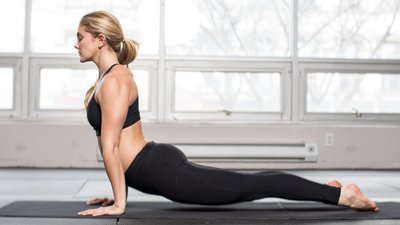
An Introduction To Yoga!
This article will explain what yoga is and includes a helpful guide to the most popular styles of yoga. Learn which style is right for you.
Ask ten different people to describe yoga, and you're likely to get ten distinct, differing responses. Attend ten different yoga classes, and you'll emerge with ten unique experiences.
Given its popularity today, this should give you a little insight into what yoga is and its relation to health and fitness, so that you don't inadvertently end up with a teacher or style of yoga that is ill-matched to your needs, abilities, and preferences.
Yoga And Asana
The word yoga means "union" in Sanskrit, the language of ancient India where yoga originated. We can think of it as the union occurring between mind, body, and spirit. Yoga is not a religion, but it is a philosophy that has endured 5,000 years.
Yoga refers to the practice of physical postures or poses called "asana's". Asana is only one type of yoga.
Today, however, the words "asana" and "yoga" have become almost synonymous. With increased awareness, the poses become meditation-in-action with awareness of the breath flowing through the body.
Each of the poses has specific physical benefits. Physical tension and imbalances are brought to attention and begin to release. The poses can be done quickly in succession, creating heat in the body through movement or more slowly to increase stamina and perfect the alignment of the pose. There is an ideal way that each pose should be performed.
Many people think that yoga is stretching. But while stretching is certainly involved, yoga is really about creating balance in the body through developing both strength and flexibility. Most types of yoga are more concerned with mental and spiritual well-being than physical activity.
Your Practice
Yoga teachers will often refer to "your practice," which means your individual experience with yoga as it develops over time. Yoga, first and foremost, must be approached in accordance to your comfort zone. No pose, technique, or instructor behavior will instill any benefit if you are at all uncomfortable.
Because yoga is so diverse, there is plenty of room for interpretation from one person to the next, even within the same classroom. You need to work at your own pace; not mine, not the neighbor's, not even your own of a week ago.
Don't ever let anyone physically push your body into a position beyond that which you are able to assume by yourself; don't let anyone coax you to go further than you wish to go.
This is your practice; only you have the wisdom to dictate where your practice goes. Although the poses themselves do not change, your relationship to them will.
Anyone can start a yoga practice, even if you don't feel like you are very flexible or very strong. These things will develop over time.
Another great thing about thinking of yoga as "your practice" is that it encourages the noncompetitive spirit of yoga. One of the most difficult, but ultimately most liberating things about yoga is letting go of the ego and accepting that no one is better than anyone else.
Everyone is just doing their best on any given day. The amazing thing about yoga is that your practice is always evolving and changing so it never gets boring.
Yoga Components
Yoga classes may also include instruction on breathing, call and response chanting, meditation, or an inspirational reading by the teacher. The variety and amount of this will depend on the individual teacher and the tradition in which they have trained.
Typically, a yoga class at a gym will be more focused on the purely physical benefits of yoga, while one at a yoga center may delve more into the spiritual side.
Some people find that the physical practice of yoga becomes a gateway into a spiritual exploration while others just enjoy a wonderful low-impact workout that makes them feel great. Whatever your tendency, you will be able to find a yoga class that suits your style.
Styles Of Yoga
There are many different styles of yoga being taught and practiced today. Although all of the styles are based on the same physical postures (called poses), each has a particular emphasis. Here is a quick guide to the most popular types of yoga that can help you decode the schedule at your gym and figure out which class is right for you.
Hatha
Hatha is a very general term for slow-paced and gentle yoga, and can provide a good introduction to the basic yoga poses.
Vinyasa
Vinyasa, which means breath-synchronized movement, tends to be a more vigorous style based on the performance of a series of poses called "Sun Salutations" in which movement is matched to the breath.
Ashtanga/Power Yoga
Ashtanga, which means eight limbs in Sanskrit, is a fast-paced, intense style of yoga practice. A set series of poses is performed, always in the same order. Ashtanga practice is very physically demanding, because of the constant movement from one pose to the next.
Ashtanga is the inspiration for what is often called "Power Yoga." If a class is described as Power Yoga, it will be based on the flowing style of Ashtanga, but not necessarily keep strictly to the set Ashtanga series of poses.
Iyengar
This style of practice is most concerned with bodily alignment, which is the precise way in which your body should be positioned in each pose in order to obtain the maximum benefits of the pose and avoid injury. Iyengar practice usually emphasizes holding poses over long periods versus moving quickly from one pose to the next.
Kundalini
The emphasis in Kundalini is on the breath in conjunction with physical movement, with the purpose of freeing energy in the lower body and allowing it to move upwards. Kundalini uses rapid, repetitive movements rather than holding poses for a long time, and the teacher will often lead the class in call and response chanting.
Bikram/Hot Yoga
Pioneered by Bikram Choudhury, this style is more generally referred to as Hot Yoga. It is practiced in a 95-100 degree room, which allows for a loosening of tight muscles and profuse sweating, which is thought to be cleansing.
Strength And Cardio
Very vigorous types of yoga practice such as Ashtanga and "Power Yoga" are cardiovascular exercise and may help you lose weight, if done regularly, along with a diet plan.
Doing any type of yoga will build strength, but some types may not raise your heart rate enough to constitute the only form of exercise necessary to a weight loss regime. So don't use this as a substitute to weights and cardio.
If you are brand new to yoga, you may want to take a few Hatha classes to learn the basic poses. However, Hatha is usually slow-paced, so if you are the kind of person who likes to move around more, Hatha may turn you off.
Even if you are already in great shape, take a few beginners' classes to learn the poses and avoid the risk of injury. And while there are many great yoga books and videos available, there is no substitute from learning directly from a good teacher in a yoga class.
Anyone may practice yoga to keep their bodies fit and supple or for relief from back or joint pain, injuries or stress. Others want to feel the joy and energy yoga imparts. Hatha Yoga helps free people from limiting beliefs, even those who feel they are too old, too stiff, or too out of shape.
Health Benefits Of Yoga
There are many benefits of practicing yoga. Here are a few:
- You'll feel more relaxed and learn to stay relaxed.
- Your overall muscle tone improves as well as alignment.
- You'll add vitality to your spine, improving all systems of the body, especially the glands and nerves.
- Digestion improves; gas and bloating lessens.
- Your lungs expand, increasing oxygen intake.
- You'll sleep better.
- You'll be less tired during the day with higher energy.
- Your immune system will strengthen.
- You'll learn to set aside time for yourself.
- You'll learn to trust yourself more.
Performed properly with a qualified teacher, the therapy of yoga movement often benefits physical conditions. Health improves as a result of improved alignment, flexibility or strength. Remember to discuss any issues of health with your medical professional and your teacher prior to starting your class.
And just too simply set the record straight: Your chances of achieving an ultra-fit "celebrity body" just by practicing yoga are—no pun intended—slim. This is certainly not to say that yoga can't help deliver impressive fitness results. But it takes other forms of exercise—such as cardiovascular training—to help round out the fitness benefits of any yoga practice.
Furthermore, many of yoga's numerous benefits—for example, increased flexibility, postural alignment, low-back strength, abdominal tone, stress reduction—are far from instantaneous.
Conclusion
This is not a "10 days to complete fitness" kind of activity. Part of what makes yoga so beneficial is its power in influencing vast changes in your body and health over time.
So, keep your expectations realistic, and give yourself a sufficient time frame—at least 8-12 weeks—with which to assess your progress, and you will be much more likely stick it out long enough to see those wonderful results materialize!
